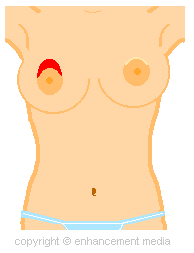Beast Lift Techniques: Crescent, Benelli and Full Mastopexy
The crescent mastopexy:
|
The crescent lift technique involves removing a crescent-shaped piece of tissue above the areola and resuturing the tissue higher. This procedure creates a minor lift for patients who have slight breast ptosis. Slightly egg-shaped areolae may result in heavier breasts or in patients who do not wear good, supportive bras postoperatively. This is due to the skin stretching and the tension at the incision line. |
 |
The Benelli lift:
Also known as concentric, periareolar or doughnut lift, this less invasive technique was developed so that the breast lift scars fall in the lines around the areolae. With the Benelli, a doughnut-shaped piece of tissue around the areola border is removed and the surrounding tissue is sutured to the areola. The incisions are normally closed with purse string sutures. Sometimes a little more tissue is removed above the areola (as in the crescent) to compensate for a lifting effect when it is sutured. It sometimes results in a flatter, rounder breast shape postoperatively.
The Benelli-Lollipop:
This lift is the same as the Benelli but with straight breast lift incisions from under the areolae to the mammary folds. This technique is for women who have medium ptosis, too much for the Benelli only and too little for a full anchor incision.
Full Mastopexy (anchor):
The most commonly used technique uses an anchor-shaped incision that starts at the base of the areola and follows vertically to the point where the breast meets the rib cage. The incision then cuts out a crescent-shaped piece of skin right above where the breast meets the rib cage. Nipple repositioning is sometimes necessary with this technique as the nipple must be "removed" and reattached. This is considered one of the major scarring techniques, but it is sometimes necessary to lift severely sagging breasts. With the standard mastopexy, the incisions are made in the shape of an anchor at the natural crease of the breast up to the areola and nipple area. An areolae reduction or relocation is sometimes needed to decrease the size of the areolae complexes. Sometimes periareolar incisions will "pucker", but this usually flattens out over time, especially with the use of medical paper tape and/or silicone sheeting.

